
Pool of Radiance is a role-playing video game developed and published by Strategic Simulations, Inc (SSI) in 1988. It was the first adaptation of TSR's Advanced Dungeons & Dragons (AD&D) fantasy role-playing game for home computers, becoming the first episode in a four-part series of D&D computer adventure games. The other games in the "Gold Box" series used the game engine pioneered in Pool of Radiance, as did later D&D titles such as the Neverwinter Nights online game. Pool of Radiance takes place in the Forgotten Realms fantasy setting, with the action centered in and around the port city of Phlan.
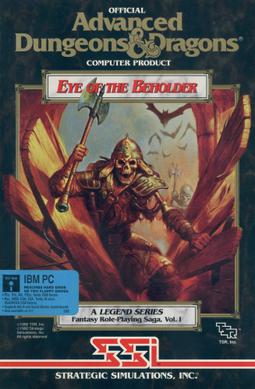
Eye of the Beholder is a role-playing video game for personal computers and video game consoles developed by Westwood Associates. It was published by Strategic Simulations, Inc. in 1991, for the MS-DOS operating system and later ported to the Amiga, the Sega CD and the SNES. The Sega CD version features a soundtrack composed by Yuzo Koshiro and Motohiro Kawashima. A port to the Atari Lynx handheld was developed by NuFX in 1993, but was not released. In 2002, an adaptation of the same name was developed by Pronto Games for the Game Boy Advance.
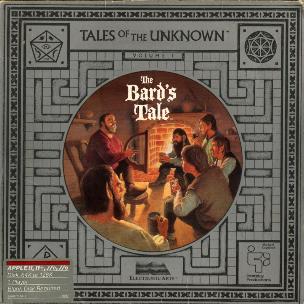
The Bard's Tale is a fantasy role-playing video game designed and programmed by Michael Cranford for the Apple II. It was produced by Interplay Productions in 1985 and distributed by Electronic Arts. The game was ported to the Commodore 64, Apple IIGS, ZX Spectrum, Amstrad CPC, Amiga, Atari ST, MS-DOS, Mac, and NES. It spawned The Bard's Tale series of games and books. The earliest editions of the game used a series title of Tales of the Unknown, but this title was dropped for later ports of The Bard's Tale and subsequent games in the series.

Curse of the Azure Bonds is a role-playing video game developed and published by Strategic Simulations in 1989. It is the second in a four-part series of Forgotten Realms Advanced Dungeons & Dragons Gold Box games, continuing the events of Pool of Radiance.
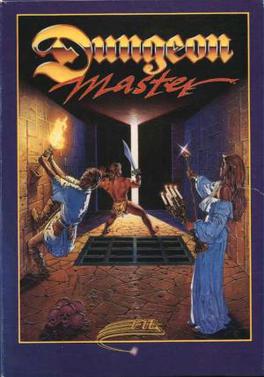
Dungeon Master is a role-playing video game featuring a pseudo-3D first-person perspective. It was developed and published by FTL Games for the Atari ST in 1987, almost identical Amiga and PC (DOS) ports following in 1988 and 1992.

Paperboy is an action game developed and published by Atari Games and released as an arcade video game in 1985. The player takes the role of a paperboy who delivers a fictional newspaper called The Daily Sun along a street on his bicycle. The arcade version of the game featured bike handlebars as the controller.

The Bard's Tale II: The Destiny Knight is a fantasy role-playing video game created by Interplay Productions in 1986. It is the first sequel to The Bard's Tale, and the last game of the series that was designed and programmed by Michael Cranford.

Arthur: The Quest for Excalibur is an illustrated interactive fiction video game written by Bob Bates and published by Infocom in 1989. It was released for the Apple II, Amiga, Mac, and IBM PC compatibles. Atypically for an Infocom product, it shows illustrations of locations, characters and objects within the game. It is Infocom's thirty-fourth game and is the second of two Infocom games developed by Challenge using Infocom's development tools.

Dragon Wars is a fantasy role-playing video game developed by Rebecca Heineman, published by Interplay Productions in 1989, and distributed by Activision.

The Faery Tale Adventure is a 1987 action role-playing video game designed by David Joiner and published by MicroIllusions for the Amiga, and later ported to the Commodore 64, MS-DOS, and Sega Genesis. The MS-DOS version is titled The Faery Tale Adventure: Book I. Microillusions also released a "Book 1" version for the Amiga which was going to be the start of a series of games, according to Talin, but bankruptcy prevented it. The initial version was produced for the Amiga 1000 and featured the largest game world to that date. A sequel, Faery Tale Adventure II: Halls of the Dead, was released in 1997.
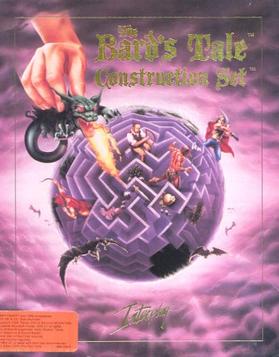
The Bard's Tale Construction Set is a computer game creation system that allows for the creation of dungeon crawl video games based on the Bard's Tale game engine. It was developed by Interplay Productions in 1991 and distributed by Electronic Arts. It was released for the Amiga and MS-DOS.
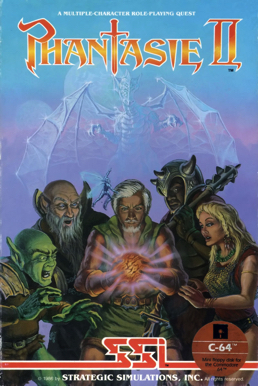
Phantasie II is the second game in the Phantasie series of role-playing video games.

Wonderland, published in 1990 by Virgin Games, is an interactive fiction game developed by Magnetic Scrolls based on Lewis Carroll's Alice in Wonderland. While playing as Alice, the player goes on a journey solving puzzles in order to find the way back home from Wonderland. With hundreds of locations to explore, the game introduced characters from the original book to guide the journey through Wonderland. First introducing the magnetic windows system, Wonderland received positive reviews upon release.
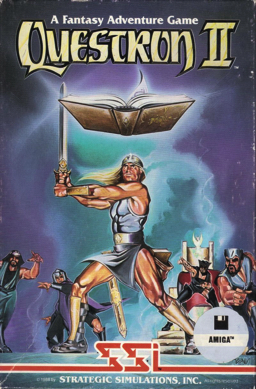
Questron II a 1988 role-playing video game published by Strategic Simulations for the Apple II, Apple IIGS, Atari ST, Commodore 64, IBM PC compatibles, and Amiga. It is the sequel to 1984's Questron. The story and original design is credited to Quest Software, while the programming and artwork is credited to Westwood Associates.

Elvira: Mistress of the Dark is a horror adventure/role-playing video game developed by Horror Soft and released by Accolade in 1990 for the Amiga, Atari ST, Commodore 64 and MS-DOS computers. It was Horror Soft's second published game after 1989's Personal Nightmare and stars the actress Cassandra Peterson as her character Elvira.
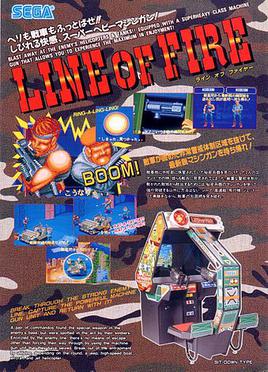
Line of Fire is a first-person light gun shooter game developed by Sega and released for arcades in 1989. It was released with two arcade cabinet versions, a standard upright and a sit-down cockpit, both featuring two positional guns. The cockpit design allows the player(s) to sit down while playing the game, while having two-handed machine guns, controlled by a potentiometer-controlled gun alignment software system. The game follows a two-man commando unit as they try to escape from a terrorist facility after seizing a prototype weapon.

The Real Ghostbusters is a 1987 shoot 'em up arcade game developed and published by Data East. It is loosely based on Ghostbusters. In Japan, Data East released it as a non-Ghostbusters arcade game under the title Meikyuu Hunter G. In 1989, Activision published The Real Ghostbusters for Amiga, Amstrad CPC, Atari ST, Commodore 64, and ZX Spectrum.
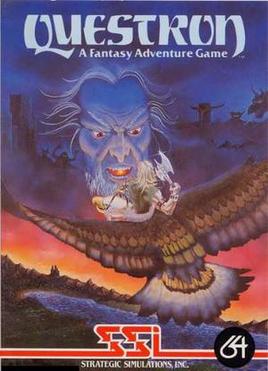
Questron is a 1984 game from Strategic Simulations, the first fantasy title from a company known for computer wargames. It was written by Charles Dougherty and Gerald Wieczorek and released for the Apple II, Atari 8-bit computers, and Commodore 64. A sequel, Questron II, was released in 1988.
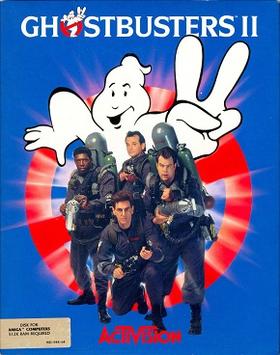
Ghostbusters II is a 1989 action game based on the film of the same name. It was published by Activision for various computer platforms. British studio Foursfield developed a version for Commodore 64, Amiga, Atari ST, Amstrad CPC and ZX Spectrum, which also got ported to the MSX by New Frontier. It features three levels based on scenes from the film. Dynamix developed a separate version for the DOS, also based on the film. The non-DOS versions were praised for the graphics and audio, but criticized for long loading times, disk swapping, and the final level. The DOS, Commodore 64 and Amiga versions were the only versions released in North America.

Judge Dredd is a 1991 platform shoot 'em up video game based on the character of the same name. It was developed by Random Access and published by Virgin Mastertronic. It was released in Europe in 1991, for the Amiga, Atari ST, Commodore 64, and ZX Spectrum. Critics found the gameplay repetitive.




















